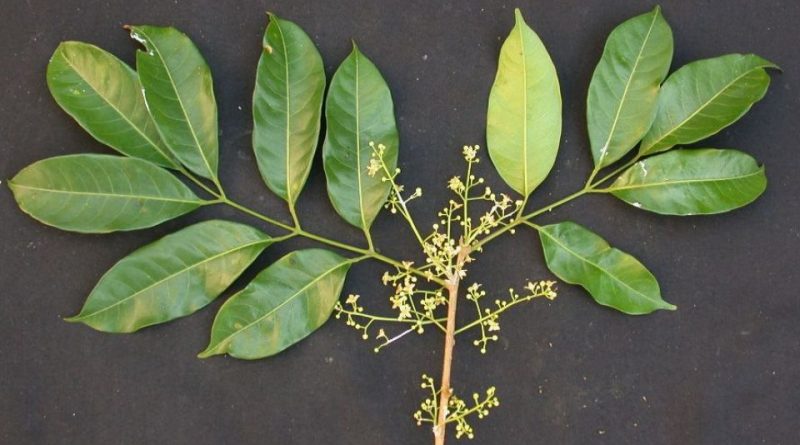Protium guianense
Protium guianense
The Bois D’encens or Incense Tree, Incense Wood, Kourouky, Loban, White Incen (Protium guianense (Aubl.) Marchand) is an arboreal species belonging to the Burseraceae family.
Systematics –
From a systematic point of view it belongs to:
Eukaryota Domain,
Kingdom Plantae,
Magnoliophyta Division,
Magnoliopsida class,
Sapindales Order,
Burseraceae family,
Genus Protium,
P. guianese species.
The terms are synonymous:
– Amyris ambrosiaca Spreng .;
– Amyris guyanensis (Aubl.) Willd .;
– Bursera guianensis (Aubl.) Baill .;
– Elaphrium guianense (Aubl.) Spreng .;
– Elaphrium guianense (Aubl.) Spreng. ex D.Dietr., 1840;
– Icica guianensis Aubl .;
– Icica heptaphylla Griseb .;
– Icica hostmannii Miq .;
– Icica viridiflora Lam .;
– Protium ambrosiacum Druce;
– Protium heptaphyllum var. puberulum Engl .;
– Protium hostmannii (Miq.) Engl .;
– Tingulonga guianensis (Aubl.) Kuntze;
– Tingulonga hostmannii (Miq.) Kuntze.
Etymology –
The term Protium is derived from modern Latin and coming from the Greek prōtos, first.
The specific Guianese or Guyanensis epithet refers to French Guiana or Guyana (formerly British) or Dutch Guyana (now Surinam).
Geographic Distribution and Habitat –
Protium guianense is a plant native to the North of South America and with a range that includes Brazil, Bolivia, Peru, Ecuador, Venezuela and Guyana.
Its natural habitat is that of rainforests and savannah forests, especially along rivers and on sandy soils, which is usually found at altitudes below 600 meters but occasionally extends up to 1,000 meters and with the presence of plants up to 1,600 meters in Venezuela.
Description –
Protium guianense is a small tree up to 6 meters tall with specimens that can occasionally reach 10 meters.
Branches, rachis and leaflets are covered with a fine whitish pubescence.
The leaves are alternate, compound, odd-pinnate, with 2-3 pairs of leaflets (2.5-13 x 1-4.5 cm), leathery, ovoid, with lanceolate tip, dark green on the upper side and slightly lighter green on the lower one.
The inflorescence is panicle, axillary or sub-terminal.
The flowers are creamy greenish-white pentamers.
The fruit is an obovoid drupe, reddish-brown in color, dehiscent, with a seed that is a white aril.
The structures emit a sweet and strong smell. Crystalline resin which is white when dried.
Cultivation –
Protium guianense is a small tree that is harvested in nature for local use as a medicine and source of resin.
For its cultivation it should be remembered that it is a plant of the tropics, dioecious so, if you want to obtain fruits and seeds, both male and female plants must be cultivated.
Propagation normally occurs by seed.
Customs and Traditions –
Protium guianese is a plant used since ancient times by the natives of the areas where it grows mainly in the undergrowth.
The sap of this plant is used to purify the stomach while the resin is used as a cough remedy.
An alcoholic tincture obtained from the aromatic resin is used as a topical application for ulcers; to treat phthisis and to relieve asthma.
A resin known as “Elemi of Guiana” is obtained from the area around the inner bark of the tree. This is very aromatic and is used to make lacquers and also as incense in churches.
It can also be used as an enamel on ceramic.
This scented resin can be used to make paints, inks, ointments, perfumes, etc.
The resin is burned as a mosquito repellent.
The resinous bark of this plant is also used to light fires and also as a torch to provide light.
In its native range, this plant is also grown for timber, used as firewood, or as a source of medicines, for its fruits or for resin.
Preparation Method –
Of the Guianese Protium, both the sap and the resin are used for medicinal purposes.
The resin is obtained by making incisions in the bark and leaving it to thicken to harden; after which it is collected.
Furthermore, an alcoholic tincture is obtained from the resin which is used as a topical application for ulcers, for phthisis and for asthma.
Guido Bissanti
Sources
– Acta Plantarum – Flora of the Italian Regions.
– Wikipedia, the free encyclopedia.
– Useful Tropical Plants Database.
– Conti F., Abbate G., Alessandrini A., Blasi C. (ed.), 2005. An annotated checklist of the Italian vascular flora, Palombi Editore.
– Pignatti S., 1982. Flora of Italy, Edagricole, Bologna.
– Treben M., 2000. Health from the Lord’s Pharmacy, Advice and experiences with medicinal herbs, Ennsthaler Editore.
Photo source: https://herbariovaa.org/imglib/neotrop/misc/201406/17904_1403281122_web.jpg
Warning: Pharmaceutical applications and alimurgical uses are indicated for informational purposes only, they do not represent in any way a medical prescription; therefore no responsibility is taken for their use for curative, aesthetic or food purposes.


